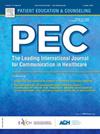Shared decision making for people living with multimorbidity: A concept analysis
IF 2.9
2区 医学
Q2 PUBLIC, ENVIRONMENTAL & OCCUPATIONAL HEALTH
引用次数: 0
Abstract
Objective
As part of patient-centered care, shared decision making (SDM)—where healthcare professionals (HCPs) and patients collaboratively choose treatments based on medical evidence and patient preferences—is essential for patients with multimorbidity facing varied benefits and risks. However, there is no clear conceptual understanding of what it represents. This study aims to analyze SDM concept for individuals with multimorbidity, clarifying key elements and guiding effective patient engagement in complex care decisions.
Methods
A concept analysis was undertaken using Walker and Avant's approach based on a literature review.
Results
SDM is a fundamental concept in health promotion for people with multimorbidity, assisting patients and HCPs in defining priorities, making choices, developing strategies, and executing them to improve health. Four core attributes were identified: (1) partnership based on mutual trust; (2) multidimensional information exchange; (3) complex trade-offs; (4) iterative communication and evaluation. Antecedents were divided into factors (complexity of diseases and multiple health needs from patients; communication skills from HCPs; consultation time, training and policy from health system). Consequences included patient autonomy and improved decision-making quality, patient satisfaction and symptom relief, and efficient utilization of medical resources.
Conclusions
Our findings offer insights into refining the concept of SDM in the context of multimorbidity. This concept analysis serves as a foundation for instrument development to measure the effects or attributes of the concept and highlights the need for future practical research on SDM that goes beyond involvement and engagement.
Practice implications
To implement SDM effectively for multimorbid patients, healthcare systems should enhance HCPs' communication skills, allocate sufficient consultation time to address complex needs, support SDM through policy, and develop tools to assess decision quality, patient satisfaction, and medical resource utilization.
多重疾病患者的共同决策:概念分析
作为以患者为中心的护理的一部分,共享决策(SDM) -医疗保健专业人员(HCPs)和患者根据医学证据和患者偏好协同选择治疗方法-对于面临不同收益和风险的多病患者至关重要。然而,对于它所代表的东西,并没有一个清晰的概念性理解。本研究旨在分析多病个体的SDM概念,阐明关键因素并指导患者有效参与复杂的护理决策。方法在文献回顾的基础上,采用Walker和Avant的方法进行概念分析。结果ssdm是多病人群健康促进的一个基本概念,可帮助患者和医务人员确定重点、做出选择、制定策略并实施以改善健康。发现了四个核心属性:(1)基于相互信任的伙伴关系;(2)多维信息交换;(3)复杂的权衡;(4)迭代沟通与评估。前因分为因素(疾病的复杂性和患者的多重健康需求;来自医护人员的沟通技巧;咨询时间、培训和卫生系统政策)。结果包括患者自主和决策质量的提高,患者满意度和症状缓解,以及医疗资源的有效利用。结论我们的研究结果为在多病背景下完善SDM的概念提供了见解。这一概念分析可以作为工具开发的基础,以衡量概念的影响或属性,并突出了未来对SDM的实践研究的需求,而不仅仅是参与和参与。实践意义为了在多病患者中有效实施SDM,医疗保健系统应提高医务人员的沟通技巧,分配足够的会诊时间来解决复杂的需求,通过政策支持SDM,并开发评估决策质量、患者满意度和医疗资源利用率的工具。
本文章由计算机程序翻译,如有差异,请以英文原文为准。
求助全文
约1分钟内获得全文
求助全文
来源期刊

Patient Education and Counseling
医学-公共卫生、环境卫生与职业卫生
CiteScore
5.60
自引率
11.40%
发文量
384
审稿时长
46 days
期刊介绍:
Patient Education and Counseling is an interdisciplinary, international journal for patient education and health promotion researchers, managers and clinicians. The journal seeks to explore and elucidate the educational, counseling and communication models in health care. Its aim is to provide a forum for fundamental as well as applied research, and to promote the study of organizational issues involved with the delivery of patient education, counseling, health promotion services and training models in improving communication between providers and patients.
 求助内容:
求助内容: 应助结果提醒方式:
应助结果提醒方式:


